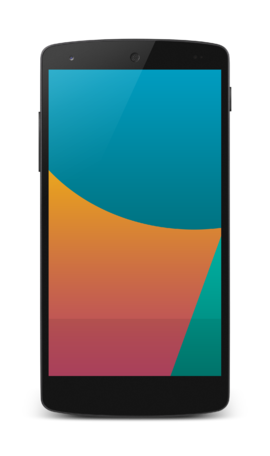Nexus 5
 |
|

Front view of the Nexus 5
|
|
| Codename | Hammerhead |
|---|---|
| Developer | Google, LG Electronics |
| Manufacturer | LG Electronics |
| Series | Google Nexus |
| Compatible networks | 2G/3G/4G LTE GSM: 850/900/1800/1900 MHz Model LG-D820 (North America) CDMA band class: 0/1/10 WCDMA bands: 1/2/4/5/6/8/19 LTE bands: 1/2/4/5/17/19/25/26/41 Model LG-D821 (international) WCDMA bands: 1/2/4/5/6/8 LTE bands: 1/3/5/7/8/20 |
| First released | October 31, 2013 |
| Availability by country |
31 October 2013
27 November 2013
|
| Discontinued | 11 March 2015 |
| Predecessor | Nexus 4 |
| Successor | Nexus 6, Nexus 5X |
| Related | LG G2, Nexus 7 (2013) |
| Type | Smartphone |
| Form factor | Slate |
| Dimensions | 137.84 mm (5.427 in) H 69.17 mm (2.723 in) W 8.59 mm (0.338 in) D |
| Weight | 130 g (4.6 oz) |
| Operating system | Android "KitKat" 4.4, upgradable to Android "Marshmallow" 6.0.1 |
| System on chip | Qualcomm Snapdragon 800 |
| CPU | 2.26 GHz quad-core Krait 400 |
| GPU | Adreno 330, 450 MHz |
| Memory | 2 GB of LPDDR3-1600 RAM |
| Storage | 16 GB (12.55 GB available) or 32 GB (26.7 GB available) |
| Removable storage | Not available |
| Battery | 3.8 V 2300 mAh, 8 Wh Qi wireless charging non-replaceable |
| Data inputs | Multi-touch capacitive touchscreen, Proximity sensor, Gyroscope, Compass, Barometer, Accelerometer, Hall effect sensor, Ambient Light sensor, GPS,GLONASS, Beidou, step counter and detector |
| Display | 4.95 in (126 mm) Full HD 1920×1080 px (445 ppi) IPS LCD, with Corning Gorilla Glass 3 |
| Rear camera | 8 MP Sony Exmor IMX179 1/3.2-inch CMOS sensor with OIS, f/2.4 aperture and LED flash. |
| Front camera | 1.3 MP |
| Sound | Monaural lateral loudspeaker, dual microphones, 3.5 mm stereo audio jack |
| Connectivity | Micro USB, SlimPort, NFC, Bluetooth 4.0, Wi-Fi 802.11 a/b/g/n/ac (single stream) |
| Other | Multi-color LED notification light |
| SAR | Head: 0.810 W/kg (1 g) Body: 0.998 W/kg (1 g) Hotspot: 0.998 W/kg (1 g) |
Nexus 5 (codenamed Hammerhead) is an Android smartphone manufactured by LG Electronics for Google. Co-developed with and marketed by Google Inc. as part of its Nexus line of flagship devices and unveiled on October 31, 2013, it is a successor to the Nexus 4. Nexus 5 served as the launch device for Android 4.4 "KitKat", which introduced a refreshed interface, performance improvements, increased Google Now integration, better battery life and other features.
The Nexus 5 received mostly positive reviews, praising the device's balance of overall performance and cost in comparison to other "flagship" phones, along with the quality of its display and some of the changes introduced by Android 4.4. The display was, however, criticized for being too dim in comparison to other devices, and the camera was criticized for having inconsistent quality.
The device was unveiled on October 31, 2013; it was made available for pre-order from Google Play Store the same day in 16 GB and 32 GB models. When released, the Nexus 5 was priced at US$349 (16 GB version) and US$399 (32 GB version) in the US. This was much lower than comparable smartphones, which would cost around $649.
As of 11 March 2015[update], the Nexus 5 is no longer available from Google Play Store.
The exterior of the Nexus 5 is made from a polycarbonate shell with similarities to the 2013 version of Nexus 7, unlike its predecessor that uses a glass-based construction. Three exterior colors are available: black, white and red.
Its hardware contains similarities to the LG G2; it is powered by a 2.26 GHz quad-core Snapdragon 800 processor with 2 GB of RAM, either 16 or 32 GB of internal storage, and a 2300 mAh battery. The Nexus 5 uses a 4.95-inch (marketed as 5-inch) 445 PPI 1080p IPS display, and includes an 8-megapixel rear-facing camera with optical image stabilization (OIS), and a 1.3-megapixel front-facing camera. The Nexus 5 supports LTE networks where available, unlike the Nexus 4 which unofficially supported LTE on AWS Band 4 only with a hidden software option, but was not formally approved or marketed for any LTE use. There are two variants of the Nexus 5, with varying support for cellular frequency bands; one is specific to North America (LG-D820), and the other is designed for the rest of the world (LG-D821).
...
Wikipedia
